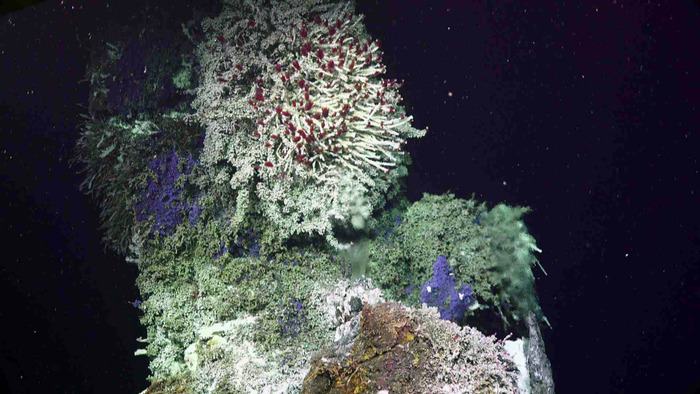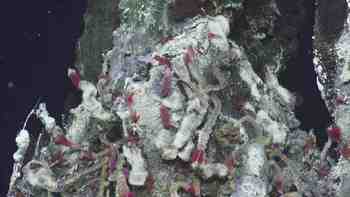The past two days again have been very busy as we check off our long list of tasks to complete for this Leg of the NSF-OOI Cabled Array cruise. The UW team has been working very long hours to get the job done as diving in the hydrothermal fields includes installing myriad instruments that take a lot of set up and care during installation. Following installation of the high definition camera, which is now streaming live for all in the world to see, we transited to the International District Hydrothermal Field to install a diverse array of instruments to measure the chemical, physical, and biological properties around and within the underwater hot springs within the field.
Diving in the International District vent field is always a highlight of our work out here. It is an amazing place where fluids, heated by the hot 1200°C magma below, jet out of the seafloor at 350°C. At 1500 meters (150 times the pressure on land), the fluids are actually boiling and hence some chimneys, such as Diva, emit fluids that are highly enriched carbon dioxide. Instruments installed during the past day include a cabled mass spectrometer, a fluid and microbial DNA sampler coincident with temperature, and a very special instrument developed by B. Seyfried and K. Ding (University of Minnesota) that measures the acidity of the high temperature fluid, its hydrogen sulfide concentration, and temperature. This instrument provides important information about the conditions deep in the volcano where high temperature mineral-fluid reactions occur. These instruments were installed in a young, hot hydrothermal site called Tiny Towers and in a white, small anhydrite chimney Dive (the pH-H2S-T sensor).
During the dive, Jason also visited the temperature-resistivity sensor in the structure called Escargot, which used to have a sulfide cap rock that looked exactly like a snail! This sensor provides real-time data on changes in chlorinity of the boiling fluids (vapors are fresh compared to seawater) and temperature. The current trend is that the fluids are getting higher in temperature and less salty. The salt concentrations change over time – sometimes they are brines and when hotter they are less salty. The salt concentration is of interest to microbiologists because they discovered halophiles in the vent fluids (organisms that are “salt-loving and which can live at up to 20 wt% sodium chloride – sea water is 3.5%). Do these high temperature organisms reflect habitats filled with brines in the nooks and crannies of the rocks below?
Data streaming 24/7 to shore from these instruments, as well as from the seismometers are being used to examine how earthquakes and eruptions impact fluid chemistry and temperature, and hence life on and within the seafloor; animals and microbes that live in some of the most extreme conditions on Earth.
After Jason installed the instruments, we went to see the tallest vent in the International and ASHES vent fields – El Guapo. The chimney is venting 350°C boiling fluids and hosts spouts on top that look like they have jets of flames coming out of them. We spent a bit of time imaging the amazingly beautiful animal communities that cover these chimneys.
Early this morning new geophysical instruments funded by the National Science Foundation to Drs. William Wilcock (UW), and Glen Sasagawa and Mark Zumberge (UCSD-SIO) were installed that will help inform us about how the roof of the volcano is deforming as it inflates due to magma movement in the subsurface, and subsequent collapse after an eruption. It was a great series of dives.




